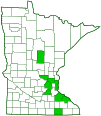flower weevils
(Odontocorynus spp.)
Overview • Description • Distribution • Taxonomy
Description |
Odontocorynus beetles are easily recognized by the distinctive shape of the antennae. However, there is significant morphological variability within every species, making identification to the species level very difficult. The front of the head is projected forward into a long snout (rostrum). Adults are 1⁄16″ to ¼″ (2.2 to 6.56 mm) in length not including the rostrum. The jaws (mandibles) are triangular. The antennae are clubbed. The first antennal segment (scape) is compressed. On the male the antennae are modified in a few ways, including an asymmetrical scape. The rear margin of the plate between the wing bases (scutellum) is notched. |
Distribution |
||
|
Sources Biodiversity occurrence data published by: Minnesota Biodiversity Atlas (accessed through the Minnesota Biodiversity Atlas Portal, bellatlas.umn.edu, 7/14/2025). |
|
| 7/14/2025 | ||
Taxonomy |
|
Order |
Coleoptera (Beetles) |
Suborder |
Polyphaga (Water, Rove, Scarab, Long-horned, Leaf, and Snout Beetles) |
Infraorder |
Cucujiformia |
Superfamily |
Curculionoidea (snout and bark beetles) |
Family |
Curculionidae (true weevils) |
Subfamily |
Baridinae (flower weevils) |
Tribe |
Madarini |
Subordinate Taxa |
|
In the 1920s, the genus Odontocorynus included 64 species. Following a recent review of the genus (Prena, 2008), only 16 species remain in the genus. Some sources continue to recognize some (NatureServe and iNaturalist) or all (GBIF and Discover Life) of the 64 species. One of the no longer recognized species that is still listed by NatureServe is Odontocorynus scutellumalbum. It was reported in Minnesota at Cedar Creek Ecosystem Science Reserve in Anoka County. That name is now a synonym of Odontocorynus umbellae. |
|
daisy flower weevil (Odontocorynus umbellae) flower weevil (Odontocorynus calcarifer) flower weevil (Odontocorynus creperus) flower weevil (Odontocorynus falsus) flower weevil (Odontocorynus histriculus) flower weevil (Odontocorynus larvatus) flower weevil (Odontocorynus latiscapus) flower weevil (Odontocorynus luteogramma) flower weevil (Odontocorynus nunume) flower weevil (Odontocorynus procerus) flower weevil (Odontocorynus pulverulentus) flower weevil (Odontocorynus subvittatus) flower weevil (Odontocorynus suturaflava) flower weevil (Odontocorynus tectus) flower weevil (Odontocorynus townsendi) rugged flower weevil (Odontocorynus salebrosus) |
|
Synonyms |
|
|
|
Common Names |
|
This genus has no common name. The common name of the subfamily Lampyridae is flower weevils, and it is used here for convenience. |
|
Glossary
Rostrum
The stiff, beak-like projection of the carapace or prolongation of the head of an insect, crustacean, or cetacean.
Scape
In plants: An erect, leafless stalk growing from the rootstock and supporting a flower or a flower cluster. In insects: The basal segment of the antenna.
Scutellum
The exoskeletal plate covering the rearward (posterior) part of the middle segment of the thorax in some insects. In Coleoptera, Hemiptera, and Homoptera, the dorsal, often triangular plate behind the pronotum and between the bases of the front wings. In Diptera, the exoskeletal plate between the abdomen and the thorax.
Visitor Photos |
||
Share your photo of this insect. |
||
This button not working for you? |
||
Mike Poeppe |
||
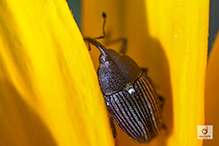 |
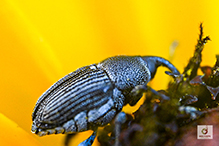 |
|
Alfredo Colon |
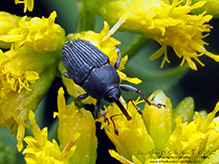 |
Odontocorynus umbellae or Odontocorynus salebrosus |
Babette Kis |
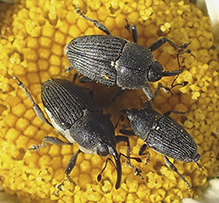 |
Flower Weevil Odontocorynus Several of these small weevils were on oxeye daisy flowers. A bright, sunny day for photos, which were taken at Barnes Prairie, Racine County, WI. on 6/27/2022. |
MinnesotaSeasons.com Photos |
||
|
||
|
||

Slideshows |
|

Visitor Videos |
||
Share your video of this insect. |
||
This button not working for you? |
||
|
Other Videos |
||
FLOWER WEEVIL, Odontocorynus with Diabrotica cristata on Coneflower |
About
Feb 28, 2020 FLOWER WEEVIL, Odontocorynus with Diabrotica cristata on Coneflower |

Visitor Sightings |
||
Report a sighting of this insect. |
||
This button not working for you? |
||
Mike Poeppe |
Location: Houston, MN |
 |
Alfredo Colon |
Location: Albany, NY Odontocorynus umbellae or Odontocorynus salebrosus |
 |
Babette Kis |
Location: Barnes Prairie, Racine County, WI Several of these small weevils were on oxeye daisy flowers. A bright, sunny day for photos, which were taken at Barnes Prairie, Racine County, WI. on 6/27/2022. |
 |
MinnesotaSeasons.com Sightings |
||
|

|
Created: 2/17/2024 Last Updated: © MinnesotaSeasons.com. All rights reserved. |
